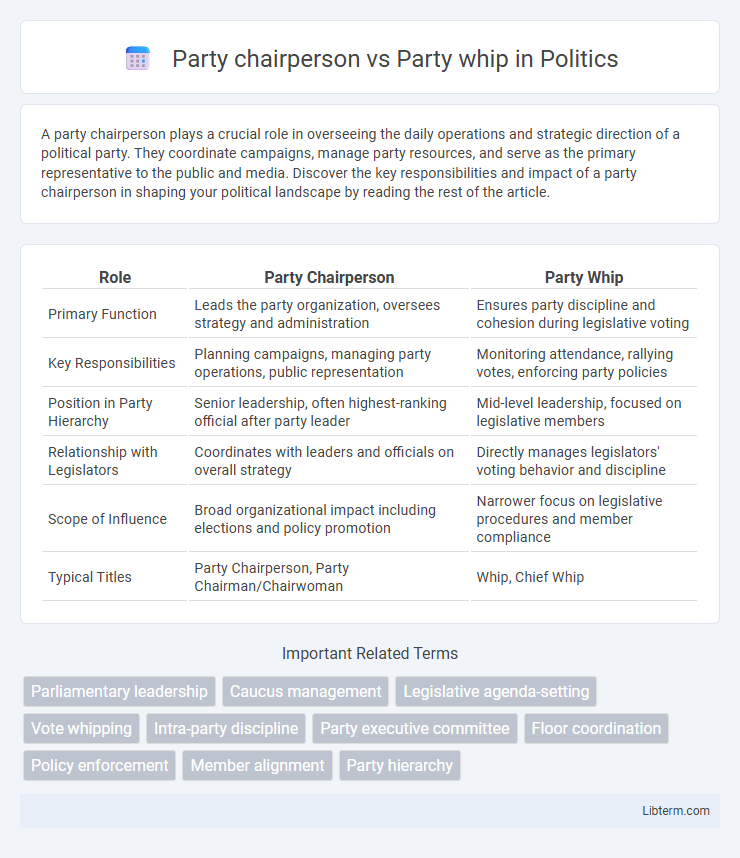A party chairperson plays a crucial role in overseeing the daily operations and strategic direction of a political party. They coordinate campaigns, manage party resources, and serve as the primary representative to the public and media. Discover the key responsibilities and impact of a party chairperson in shaping your political landscape by reading the rest of the article.
Table of Comparison
| Role | Party Chairperson | Party Whip |
|---|---|---|
| Primary Function | Leads the party organization, oversees strategy and administration | Ensures party discipline and cohesion during legislative voting |
| Key Responsibilities | Planning campaigns, managing party operations, public representation | Monitoring attendance, rallying votes, enforcing party policies |
| Position in Party Hierarchy | Senior leadership, often highest-ranking official after party leader | Mid-level leadership, focused on legislative members |
| Relationship with Legislators | Coordinates with leaders and officials on overall strategy | Directly manages legislators' voting behavior and discipline |
| Scope of Influence | Broad organizational impact including elections and policy promotion | Narrower focus on legislative procedures and member compliance |
| Typical Titles | Party Chairperson, Party Chairman/Chairwoman | Whip, Chief Whip |
Introduction to Party Chairperson and Party Whip
The party chairperson is the senior official responsible for overseeing party operations, organizing meetings, and strategizing electoral campaigns, serving as the key liaison between party members and leadership. The party whip manages party discipline by ensuring members vote according to the party line, coordinating attendance, and communicating party policies within legislative bodies. Both roles are crucial for maintaining party cohesion, with the chairperson focusing on internal administration and the whip concentrating on legislative compliance.
Key Roles and Responsibilities
The party chairperson oversees party strategy, coordinates election campaigns, and manages internal party communications to strengthen organizational unity. The party whip enforces party discipline, ensures member attendance during critical votes, and monitors voting behavior to align legislative actions with party positions. Both roles are crucial for maintaining party cohesion but focus on different aspects: strategic leadership versus legislative compliance.
Appointment and Selection Process
The party chairperson is typically appointed by the party's executive committee or elected by party members during a formal convention, reflecting broad support within the party hierarchy. In contrast, the party whip is usually selected through internal party mechanisms, often appointed by party leadership based on legislative experience and loyalty to ensure discipline among party members. Both roles require strategic placement, but the chairperson's selection emphasizes organizational leadership while the whip's appointment targets maintaining legislative order.
Authority within the Party Structure
The party chairperson holds primary authority over organizational strategy, party policies, and coordination between various party branches, ensuring unity and discipline at the top leadership level. The party whip exercises authority in legislative settings by managing party members' voting behavior, enforcing discipline, and maintaining order within parliamentary sessions. While the chairperson shapes overall party direction and public representation, the whip operates within the legislative framework to secure party cohesion and legislative success.
Influence on Legislative Decisions
The party chairperson directs party strategy and rallies support for legislative agendas, significantly shaping policy priorities and factional alignment. The party whip enforces party discipline by monitoring votes, persuading members, and ensuring quorum, directly influencing legislative outcomes. Both roles are pivotal in maintaining party cohesion and steering legislative decisions to align with party objectives.
Relationship with Party Leadership
The party chairperson acts as the primary organizer and strategist for the party leadership, maintaining close coordination with top leaders to ensure party goals and policies are effectively communicated and executed. In contrast, the party whip serves as a liaison between the party leadership and rank-and-file members, enforcing discipline and managing voting behavior to align with leadership directives. Both roles are integral to maintaining internal cohesion, with the chairperson focusing on broader strategy and the whip managing day-to-day legislative alignment.
Role in Party Discipline
The party chairperson oversees overall party organization and strategy, ensuring unity and coordinating efforts during campaigns. The party whip specifically enforces party discipline by managing member attendance and securing votes on key legislation. While the chairperson shapes party direction, the whip maintains internal order and compliance within the legislative body.
Public Representation and Media Interaction
The party chairperson serves as the primary public representative and spokesperson, shaping the party's image through strategic media engagement and addressing broad policy issues. In contrast, the party whip focuses on internal legislative discipline and communication, maintaining party unity rather than direct media interaction. While the chairperson manages public perception and media narratives, the whip's role is crucial behind the scenes to ensure cohesive party voting and legislative effectiveness.
Impact on Party Unity and Strategy
The party chairperson plays a crucial role in shaping party unity by fostering cohesion among members and coordinating overall strategic direction. The party whip ensures discipline by monitoring voting behavior and mobilizing members to support the party line, directly influencing legislative effectiveness. Together, their complementary functions reinforce party solidarity and advance shared political objectives.
Major Differences: Chairperson vs Whip
The party chairperson primarily oversees party strategy, administration, and public representation, ensuring organizational cohesion and effective campaign management. In contrast, the party whip focuses on maintaining discipline within the legislative body, securing member attendance, and ensuring votes align with party positions. The chairperson operates at a broader party level, while the whip's role is centered on legislative coordination and vote management.
Party chairperson Infographic

 libterm.com
libterm.com